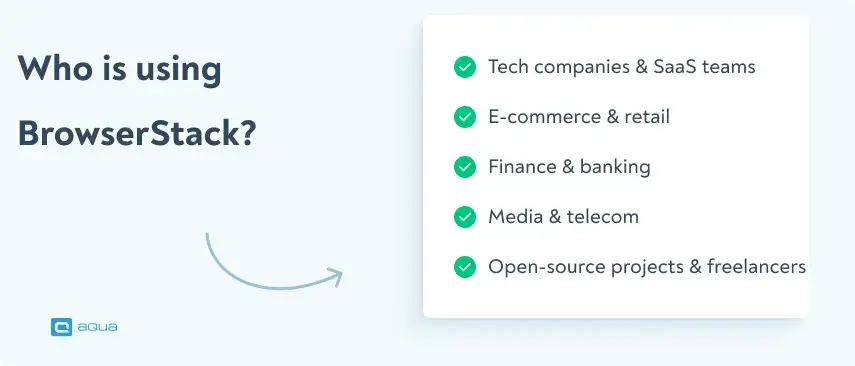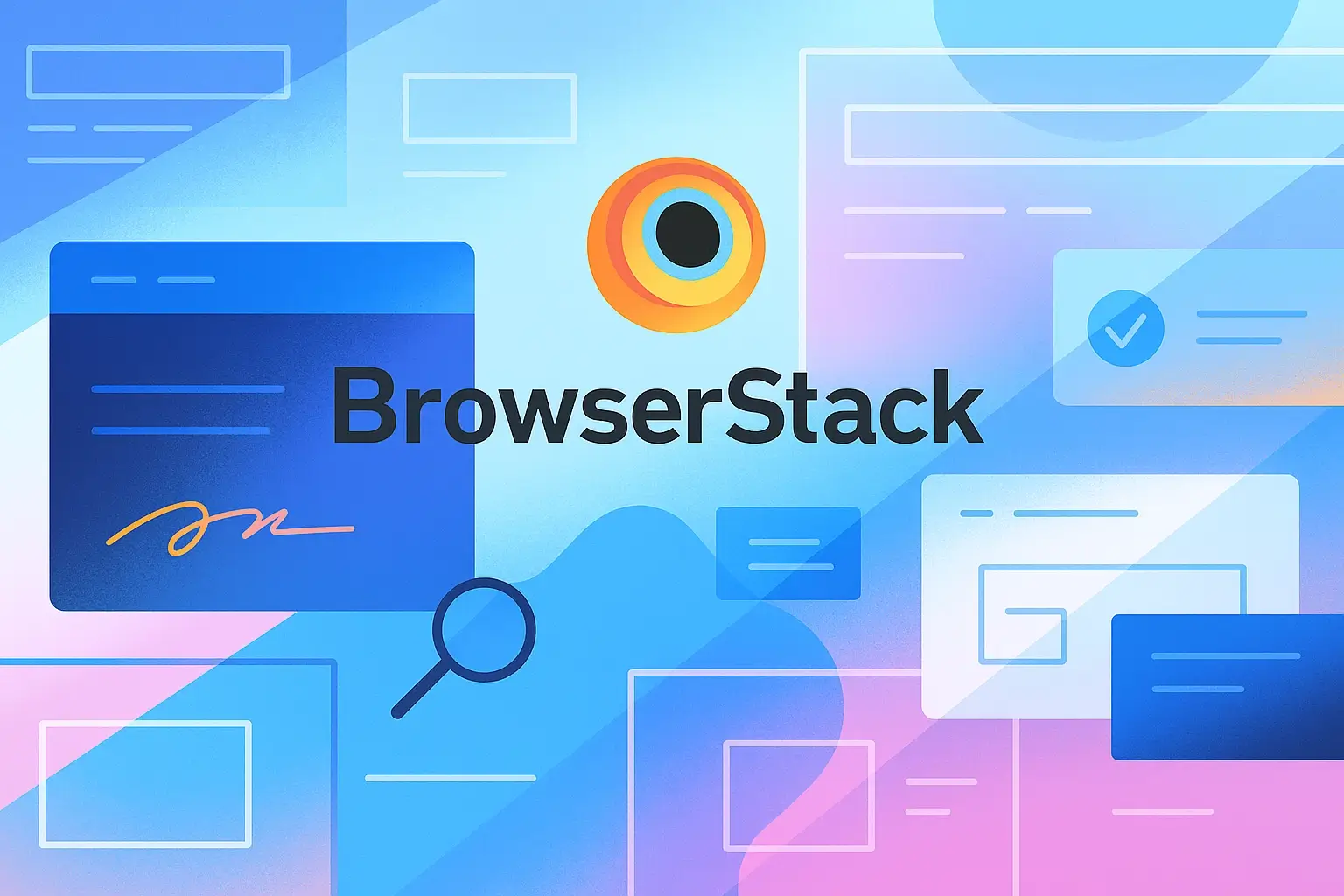What is BrowserStack?
BrowserStack is a cloud-based cross-browser and mobile testing service. It provides on-demand access to real web browsers and mobile devices hosted on the cloud.
The main goal of this service is to make sure the testers can verify that their applications work correctly in different environments without maintaining an in-house device lab. It is one of the largest unified testing platforms, and operates in 19 global data centres and 20,000+ real devices and browsers. It powers nearly 1 billion tests per year. Over 50,000 companies use BrowserStack. Quite big numbers, for sure.
BrowserStack supports everything from functional and regression testing to visual, performance, and even API testing.
How does BrowserStack work?
BrowserStack works by hosting browsers and devices in the cloud and streaming them to your local machine. When you initiate a test (either manually via the BrowserStack web dashboard or via an automated script), the platform spins up a fresh virtual machine (VM) or connects you to a real mobile device in one of their data centres.
Each testing session runs on a pristine machine, meaning every browser instance or device is reset to a clean state with default settings, no cookies or cache, and no residual data from previous tests.
This guarantees a consistent baseline for each run and prevents tests from interfering with one another. As BrowserStack’s security policy states: “Each time a new testing session is created, the BrowserStack cloud assigns the user a pristine virtual machine… caches are erased, cookies are deleted, and all running processes are killed… providing an ideal test scenario.”
BrowserStack lets you test on real browsers and devices directly from your web browser, streaming them to you like remote desktops. You can click, scroll, and type as if the device were right in front of you.
Behind firewalls, everything is supposed to work over secure HTTPS and WSS connections. For automated testing, you point your Selenium or Appium scripts to BrowserStack’s cloud, and it runs them for you while logging results. If you need to test something local, there’s a tunnelling feature that connects your dev environment to the cloud, so even your localhost can be tested on real devices.
Who Uses BrowserStack?
A wide range of people can use BrowserStack as it is intended for businesses of all sizes, and its feature set is rich. Let’s look at some of them:
- Tech companies & SaaS teams: From startups to giants, dev and QA teams use BrowserStack to check cross-browser issues, especially for web apps.
- E-commerce & retail: Online stores rely on it to test how their sites behave on different devices, which is critical when every friction point can cost a sale.
- Finance & banking: Banks and payment providers like Wells Fargo and PayPal choose BrowserStack for its real device coverage and security.
- Media & telecom: Companies like National Geographic and Microsoft use it to make sure their apps look great everywhere.
- Open-source projects & freelancers: Maintainers test their frameworks for free under BrowserStack’s OSS program, while freelancers use entry plans to quickly verify key browsers.

Enough with the theoretical part. Let’s go down to the practical sides of BrowserStack and whether it will meet your expectations in 2025, in case you decide to give it a shot.
BrowserStack Features
BrowserStack promises convenience on the surface. Instant access to real devices and browsers, cloud infrastructure you don’t have to manage, and integrations with popular test frameworks. And for many QA teams, it works, as long as you don’t look too closely at the trade-offs. Below are the key features you’ll see, along with the limitations that most users only realise after adopting the platform.
Test Management (or Lack of It)
In late 2023, BrowserStack introduced its own test management solution. It was a long-awaited feature aimed at giving QA teams a central place to manage test cases, runs, and results. At first glance, it seemed like a step in the right direction: everything under one roof, from test planning to execution. But digging a little deeper, you’ll see it’s not ready for prime time.
Here’s what BrowserStack Test Management currently offers:
- Basic test case creation: You can write test cases manually, group them into suites, and assign them to runs.
- Manual test execution: Teams can track pass/fail results and view summaries.
- Limited visibility into history or trends: There’s no meaningful traceability between requirements, test cases, and defects.
1. It would be nice if we could also drag and drop the test cases inside a test run
2. It would also be a game-changer if we could filter test runs by tags. My team and I would love to use tags a bit more, but at the moment, we feel its usage is pretty limited.
BrowserStack’s attempt at test management is quite a common issue in the QA world. Tools that try to do everything often excel at nothing. While their test execution platform is solid, their test management feels forced. Mostly, they are basic functionality wrapped around their core offering without the depth that you need.
The gaps are obvious: no advanced filtering, limited reporting capabilities, poor integration between test planning and execution, and virtually no intelligence built into the workflow. If you are a team managing hundreds or thousands of test cases across multiple projects, these limitations are productivity killers.
This is exactly where aqua cloud comes in. While BrowserStack is only just entering the test management space, aqua cloud has spent over a decade perfecting it.
With aqua, you go beyond just managing test cases. You generate them from requirements using AI. You don’t just track pass/fail, you link every test to user stories, risk factors, and automated runs. You get full traceability, visibility, and control, backed by intelligent features that make your QA faster and sharper.
- AI-powered test case generation: Turn natural language or voice input into executable test cases in seconds.
- Centralised repository: Combine manual, automated, and exploratory tests under one roof, with full versioning and history.
- Built-in bug tracking: Capture video evidence, logs, and environment details, and send them to developers in one click.
- DevOps integration: Connect seamlessly with tools like Jira, Selenium, Jenkins, Azure DevOps, and more.
In other words, while BrowserStack tries to become a test management tool, aqua already is, and has been for years. So what are you waiting for?
Achieve 200% Test Management Efficiency with a dedicated AI-powered TMS
Live Testing on Real Devices and Browsers
BrowserStack’s biggest selling point is Live Testing. You can manually test your app on a variety of browsers and devices, streamed directly to your browser. It’s ideal for spotting visual bugs across environments without owning any physical hardware.
But it’s not always smooth sailing.
- Lag is real: Input latency sometimes makes UI validation (especially animations) frustrating. When you’re testing on iOS or under network simulation, it can feel like you’re testing underwater.
- Limited screen fidelity: You’re working through a video stream, not the actual device, so don’t expect pixel-perfect colour or performance.
- Inconsistent availability: Sometimes the device you need is in use or sluggish to respond, making tight testing schedules harder to manage.
“Doesn’t work. I tried their Live browser feature to test my localhost website. I followed their instructions perfectly to properly install the BrowserStack Local app. Connecting to my localhost was nearly impossible, and I had to pray to get lucky for it to actually go through. I wasted days debugging and of course, 40$ for the subscription.”
— Five B, reviewer on TrustPilot
Automated Testing with Selenium, Cypress & Appium
BrowserStack Automate lets you run your test scripts in the cloud without setting up your own grid. In theory, this means faster testing and wider coverage. In practice?
- Concurrency limits: Even one parallel test slot can bottleneck teams. Scaling up means scaling costs—fast.
- Random flakiness: Sessions hang, tests timeout, and sometimes runs don’t even start. It’s not frequent, but it’s disruptive.
- Debugging pain: Logs and videos help, but when something fails mid-session, you’re left guessing whether it’s your code or BrowserStack’s grid.
Just my two cents: BrowserStack is slow and cumbersome. Also expensive and not worth it unless you have the money to spare and want to test ok some obscure mobile configuration. Oh, also, it doesn't work with VPN, which was a big deal in my previous company. I guess it still would be if we used them in my current workplace since VPN's are now widespread thanks to Work from Home.
So yeah running tests in CI/CD is the way to go.
Local Testing with BrowserStack Local
Need to test a staging site or local build? BrowserStack offers a tunnelling solution called “Local Testing.” You run a binary or browser extension, and it exposes your local environment to BrowserStack devices.
- The setup is simple, when it works.
- But reliability is shaky: Dropouts and connection issues are common, especially in strict corporate networks.
- No VPN compatibility by default: Testing VPN-restricted apps requires advanced setup (or compromises).
“Had issues with local testing for 6+ months. Made around 5 attempts to get help from the support staff and engineers, but all of my requests were ignored. Shout out to Manvi for ignoring my messages.”
— Trustpilot review, 2024
Device & Browser Coverage
BrowserStack boasts over 3,000 browser/OS combinations and 20,000+ real devices. On paper, it’s unbeatable. In practice, many QA teams only need a handful of environments, and accessing the latest ones isn’t always instant.
- High-volume device lab, but shallow depth: Niche devices are often missing or lag in availability.
- New OS updates take time: When iOS 17 rolled out, some teams reported waiting days before it showed up on BrowserStack.
“Time wasted, and it doesn’t even work. I will not recommend buying any plan, even no need to sign up.”
—Rehan Khan, TrustPilot
Debugging Tools & Test Evidence
BrowserStack provides session logs, video recordings, and basic console/network logs. This helps when a test fails, but it’s not always enough.
- Console logs often miss context
- Screenshot tools feel dated—annotating bugs mid-test is clunky
- Video playback is hit or miss—some sessions don’t record, and navigating long recordings is painful
Too many steps to capture and file a simple bug. For teams that prioritise fast, clear developer handoff, BrowserStack doesn’t go far enough.
Integrations & CI/CD Support
BrowserStack integrates with major CI tools (Jenkins, GitHub, Azure Pipelines) and offers plugins for Jira, Slack, and Trello.
But the experience isn’t flawless:
- Integration setup can be tedious, especially with test management platforms
- Jira links break or lose metadata
- No native support for test case traceability—everything’s stitched together externally
Test Reporting & Visibility
BrowserStack offers a test dashboard to view results from both Live and Automate sessions. It includes test status, video playback, device info, and logs.
Still, many teams feel underwhelmed:
- No centralised reporting across manual and automated tests
- No test plan view or milestone tracking
- Limited filtering options, especially when hundreds of tests pile up
“Sometimes the software behaves slowly and glitches out. I find myself having to restart multiple times just to get everything working.”
— SoftwareAdvice Review
BrowserStack Customer Support
This is where things get ugly. Customer support should be the essence of every product and service, as there will inevitably be some issues when using it. It is important how you deal with these complaints and issues.
The biggest problem BrowserStack has is its billing & cancellation process and support’s role in it. Let’s look at some reviews:
“I’m totally disappointed with this product, I almost didn’t use my subscription because of crappy slow Live Testing until you ran out of credits. Even if you’re not using the Live testing, the app is still running. You will not be able to manually remove the payment/card details as soon as you enter it, you will have to contact the support to do it. There’s no cancellation option as well, everything you will need to contact their support, which will take time for them to get contacted. If you’re going to test this product, be mindful, otherwise you’ll be surprised.”
—TrustPilot Review
“Awful cancellation process, it takes about 20 minutes. You fill out a form and then have to talk to an agent. Complete joke, avoid like the plague”
“I don’t understand why there are still companies out there that think that making it difficult to cancel will make them money. It’s not like I will give up and keep paying while I don’t use their services anymore. I was actually taking a break from my subscription. But now I spent so much effort trying to cancel, I’m actually never going to resubscribe again. You just lost a customer.”
“I wanted to try it for 20 minutes and paid 20$ for a really bad experience. A month later (of course, they are charging at the beginning of the month), I’ve noticed they are still charging my account for another 20$. There is no button for the subscription, no chat, still waiting for support to answer my emails. Stay away from this kind of scam and especially don’t supply them with your credit info because this one also cannot be deleted.”
So these (and many other reviews should tell you something.
Why go for a solution where you won’t get any answer for your complaints & get charged?
We offer a better alternative.
aqua cloud’s approach to customer service becomes a competitive advantage. Our customer support is known for its exceptional responsiveness, providing answers within 2 hours, an emphasis on German-quality precision that reflects our commitment to your success. Every ticket raised is prioritised to ensure your concerns are addressed promptly and thoroughly. When you’re troubleshooting a critical test scenario or need guidance on advanced features, you don’t have time to wait. With 20 years of market experience, aqua combines powerful features with top-tier support, making it a superior choice over alternatives that treat support as an afterthought.
Avoid scams, get a 100% dedicated account manager for the service you get
BrowserStack Pricing
BrowserStack positions itself as a premium cloud testing platform, and the pricing reflects that. While it does offer a solid feature set for cross-browser and mobile testing, it’s not the most budget-friendly option, especially once your team grows or starts automating tests at scale.
The entry point for individuals is relatively modest:
- Live testing starts at $39/month per user (for desktop browsers only).
- Want to test on mobile too? That jumps to $49/month.
- Need more than one parallel test or multiple users? Prepare to pay $150–$300/month or more, depending on your setup.
Automated testing is billed based on parallel sessions. One parallel can run you $99–$169/month, with unlimited test minutes but hard caps on how many tests you can run at once. Scaling up? So does your bill.
Extremely deceptive pricing. Essentially robbery. Beware!
They will auto-renew your plan annually without any notice whatsoever!
You won't receive any email whatsoever before they slap you with a sudden annual renewal fee up to >$1,000, even if you stopped using the product ages ago.
BrowserStack Pros and Cons
Pros:
- Extensive Device & Browser Coverage – Access to 3,000+ desktop browsers and 20,000+ real mobile devices without maintaining physical hardware.
- Cloud-Based Convenience – No setup or maintenance required; everything runs in the cloud with quick session startup.
Cons:
- Expensive & Deceptive Pricing – Premium costs that scale quickly, with auto-renewals catching users off-guard. Many report surprise annual charges exceeding $1,000.
- Terrible Customer Support & Cancellation Process – No easy cancellation button, forcing users through lengthy support processes. Support often ignores requests or provides vague responses.
- Unreliable Performance & Flaky Sessions – Frequent lag issues, sessions that hang or timeout, and inconsistent device availability that disrupts tight testing schedules.
- Weak Test Management – Their 2023 test management module lacks advanced filtering, cross-project reporting, and meaningful traceability between requirements and test cases.
- Local Testing Problems – BrowserStack Local frequently drops connections, has no VPN compatibility by default, and causes headaches in corporate network environments.
- Poor Debugging Experience – Limited console logs, clunky screenshot tools, unreliable video recordings, and too many steps to capture and file bugs effectively.
- Integration Hassles – Tedious setup processes, broken Jira links, missing metadata, and no native support for test case traceability across tools.
- Limited Customisation & Control – Isolated sessions prevent under-the-hood tweaking, and the video streaming approach lacks pixel-perfect fidelity for detailed UI validation.
The pattern is clear: while BrowserStack offers coverage, the execution falls short of expectations. Especially considering the premium price point and poor support experience.
So what should you do? You should go for a solution that offers flexibility, full control, and service worth every penny you spend.
And this solution is aqua cloud. It transforms how you approach testing: AI generates test cases from requirements in seconds, turning natural language or voice input into executable tests while competitors are still struggling with basic functionality. Complete traceability links every test to user stories, risk factors, and automated runs with 100% coverage visibility that BrowserStack simply can’t provide. Our centralised repository seamlessly combines manual, automated, and exploratory tests with full versioning, while built-in bug tracking captures video evidence and environment details in one click for instant developer handoff. Plus, our DevOps integrations actually work, connecting flawlessly with Jira, Selenium, Jenkins, and Azure DevOps without the broken links and setup headaches that plague BrowserStack users. aqua cloud has been perfecting intelligent, AI-powered testing solutions for over 20 years and delivering the reliability, transparency, and advanced capabilities that you deserve.
Generate & manage your test cases in seconds with AI-powered TMS
Conclusion
You came here wondering if BrowserStack is worth it in 2025? The answer is not simple: some customers are mainly complaining about the support, pricing and billing strategy, and performance lags. It is obvious that they’ve got impressive device coverage and should be on the top of your list for cross-browser testing purposes. However, for test management purposes, there are more dedicated solutions like aqua cloud in the market. An ideal test management often includes both these tools, using each one’s strengths together and combining their powers for maximum efficiency. Your deadlines are real, so try to use your toolkit smartly.


















